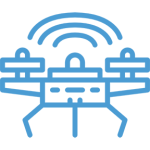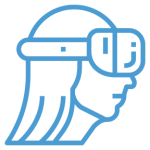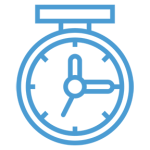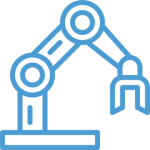Research Areas
 Autonomous and Cyber-Physical Systems
Autonomous and Cyber-Physical Systems
Subareas: Real-time and Embedded Systems, Sensor Systems, Mobile Computing, Control Theory and Systems, Formal Methods, Automated Verification and Certification
Faculty: Alterovitz, Anderson, Chakraborty, Duggirala, Nirjon
As we are rapidly moving towards the design of autonomous systems, such a disciplined approach towards the design and implementation of control algorithms, as promoted by CPS, is increasingly becoming important. The presence of complex sensors, like cameras, radars, and lidars – that are today common in autonomous cars, drones, or robots – introduce large processing delays, and offer different tradeoffs between accuracy, delay and resource requirements. These tradeoffs need to be explicitly accounted for when designing control algorithms that use such sensors. The distributed and multicore processing platforms on which control algorithms are implemented today also defy the traditional view of a centralized controller that has a synchronized access to all sensors, can compute all control inputs instantaneously, and can provide all actuations synchronously. Instead new controller design and implementation strategies that marry control theory with formal methods, and other branches of Computer Science like program analysis and compilers is becoming important.
 Bioinformatics and Computational Biology
Bioinformatics and Computational Biology
Subareas: Computational Genetics, Computational Immunology, Proteomics, Statistical Genetics, Single-Cell Bioinformatics
Faculty: Ahalt, Krishnamurthy, Marron, McMillan, Snoeyink, Stanley
Computational Immunology: Advancements in high-throughput flow and mass cytometry technologies have enabled the ability to study the immune system at an unparalleled depth. Understanding immunological adaptations to particular diseases and in aging and development offers unique opportunities to develop novel diagnostic tests or to propose specialized treatments or lifestyle interventions to optimize human health. Using single-cell flow and mass cytometry data collected across multiple individuals, our goal is to develop new computational techniques to identify and link heterogeneity in the cellular landscape to external variables of interest, such as, a clinical phenotype or diagnosis. Recent advances in imaging cytometry also enable taking images of tissues and studying the spatial organization of immune cells. Application areas of interest include pregnancy, HIV, neuroimmunology, and T-cell biology. Relevant People Natalie Stanley; Collaborating Departments: Microbiology and Immunology, Computational Medicine Program, Department of Anesthesia
Development and Differentiation, and Metagenomics: We use novel measurement techniques as well as machine learning methods in understanding the interplay between these areas, with the aim of discovering the forces that shape the immune system throughout life. The overarching goal is to apply the insights from such analyses to propose new treatments for cancers.
Single-Cell Bioinformatics: Cellular heterogeneity, or the synergy of diverse and specialized cell-types drive a range of biological phenomena. Several technologies exist for measuring various properties (e.g. gene expression, protein expression) in individual cells, which allows for their comprehensive characterization and analysis in clinical or biological applications. Single-cell measurements can be studied in vitro to understand the etiology of disease. For example, in hypoxia of heart muscle cells, the cells become scar tissue and lose their muscle function. This process can be studied by looking at single cell transcriptomes to determine the order of events. Further, it can be possible to “reprogram” this sequence of events to avoid the adverse outcome. See some of our recent work in reprogramming scar tissue cells to recover some heat muscle cell functionality.
Technologies and Data Science Problems: Single-cell datasets produced with technologies, such as single-cell RNA sequencing (scRNA-seq) or flow and mass cytometry reveal a unique data structure where there are several high-dimensional single-cell measurements per profiled sample, which need to be efficiently integrated.
Flow and Mass Cytometry: Flow and mass cytometry are high-throughput single-cell proteomics technologies for systematic analysis of the immune system. Often applied for the analysis of human blood and tissue samples, the produced datasets can collectively contain millions of cells. We focus on developing new computational techniques for representing, dissecting, and mining this large volume of cells to identify immunological adaptations in disease and development.
Relevant People: Leonard McMillan, Natalie Stanley
Molecular Structure Modeling and Analysis: Diverse biological function is encoded in the atomic structure of macro-molecules such as Proteins and RNA. Understanding the sequence to structure to function relationships allows biochemists to predict the activity of genes and rationally design genes with novel biological function. Our interests include computational geometry models for molecular structure, high performance computing for dynamic simulation, mining structure motifs for protein functional prediction, remote homology detection, protein-protein interaction, and protein-ligand interaction. Relevant People: Jack Snoeyink[/expand]
 Computer Architecture
Computer Architecture
Subareas: Accelerators, Clockless Logic, Energy-efficient Computing, Security
Faculty: Porter, Singh, Sturton
Energy-Efficient Systems: With the explosive growth in mobile devices, there has been a push towards increasing energy efficiency of computation for longer battery life. Reducing power consumption is also important for desktop computing to alleviate challenges of heat removal and power delivery. A special focus in our department has been on the development of energy-efficient graphics hardware. Another area of future interest is energy-harvesting systems, which are ultra-low-power systems that operate on energy scavenged from the environment.
Asynchronous or Clockless Computing: Asynchronous VLSI design is poised to play a key role in the design of the next generation of microelectronic chips. By dispensing with global clocks and instead using flexible handshaking between components, asynchronous design offers the benefits of lower power consumption, greater ease of integration of multiple cores, and greater robustness to manufacturing and runtime variation. Our researchers work on all aspects of asynchronous design, including circuits, architectures, and CAD tools. A key area of interest is application to network-on-a-chip for integration of multiple heterogeneous cores.
Hardware-Enhanced Security: CPU vendors are increasingly deploying hardware to support security, such as Intel’s Software Guard Extensions. We are studying hardware/software co-design to support secure execution environments that are efficient and easy to program.
 Computer Graphics
Computer Graphics
Subareas: Animation & Simulation, Graphics Hardware, Modeling, Rendering, Tracking, Virtual Environments, Visualization
Faculty: Alterovitz, Chakravarthula, Fuchs, Marks, Sengupta, Singh, Snoeyink, Daniel Szafir, Danielle Szafir
 Computer Vision
Computer Vision
Subareas: Geometric Vision, Language & Vision, Recognition
Faculty: Ahalt, Bansal, Bertasius, Marks, Niethammer, Sengupta
The goal of the Language and Vision group is to develop a better understanding of the relationship between people, their visual data, and the language they use to describe that data. In particular, this includes developing methods to: describe images or video using natural language, predict how a person will refer to specific objects in complex real-world scenes, and answer natural language questions about images. The group also works on problems related to understanding what our pictures reveal about ourselves. Tasks include clothing and style recognition and are applied to clothing recognition and other e-commerce-related problems.
 Human-Computer Interaction
Human-Computer Interaction
Subareas: Assistive Technology, Haptics, Human Factors Analysis, Sound & Audio Display, User-Interface Toolkits, Virtual Environments
Faculty: Dewan, Marks, Nirjon, Porter, Pozefsky, Srivastava, Stotts, Daniel Szafir, Danielle Szafir
Wearable devices, such as smart watches and smart glasses, and other common sensors are increasingly facilitating new modes of interaction with modern computers—making the goal of ubiquitous computing realizable. A major research direction in HCI at UNC is exploring design techniques and system support to more easily extend desktop and phone applications onto devices with widely varying form factors and interaction modes.
Another significant research direction at UNC is exploring assistive technologies for users with impairments, such as learning disabilities, blindness, and low vision. These populations face significant barriers to education and employment that we aim to reduce, as well as study different modes of interaction with computers.
UNC also undertakes projects in computer-supported collaborative work, challenging the traditional paradigm of one user on one computer and enabling distributed users to simultaneously communicate with a program to collaborate with each other.
 Machine Learning and Data Science
Machine Learning and Data Science
Subareas: Data Integration, Internet of Things, Knowledge Discovery, Machine Learning, Scientific Data Management, Visual Analytics
Faculty: Ahalt, Bansal, Bertasius, Chaturvedi, Krishnamurthy, Marks, McMillan, Niethammer, Nirjon, Oliva, Sengupta, Srivastava, Danielle Szafir, Yao
Machine Learning: The problems we study combine vast amounts and disparate types of measurements with equally complex prior knowledge, posing unique challenges for machine learning. Our interests include both modeling paradigms, such as Bayesian nonparametric methods, and inference methodologies, such as MCMC, variational methods and convex optimization. We also work on structured, interpretable, and generalizable deep learning models. Other topics of focus include multi-task learning, reinforcement learning, and transfer learning.
Internet of Things: The Internet of Things (IoT) is a fabric that is aimed at connecting every object in the world to the Internet. There are two schools of thoughts regarding IoT, emphasizing — IoT devices and networks, and IoT data analytics. Understanding both is essential to designing an end-to-end IoT system that senses the physical world, learns and makes inferences, talks to other IoT systems, and caters plethora of data-driven services that help us making better decisions, save our time, make our lives efficient, and keep us healthier.
 Medical Image Analysis
Medical Image Analysis
Subareas: Biomechanical Modeling, Diffusion Imaging, Image-guided Interventions, Segmentation, Shape Analysis, Registration
Faculty: Alterovitz, Marron, Niethammer, Oguz, Pizer, Styner
 Natural Language Processing
Natural Language Processing
Subareas: Language Generation, Multimodal and Grounded NLP (with Vision and Robotics), Question Answering and Dialogue
Faculty: Bansal, Chaturvedi, Srivastava
 Networking
Networking
Subareas: Distributed Systems, Internet Measurements, Multimedia Systems, Multimedia Transport, Network Protocols
Faculty: Aikat, Dewan, Jeffay, Kaur, Mayer-Patel, Nirjon, Pozefsky
 Operating Systems
Operating Systems
Subareas: File Systems, Virtualization, Concurrency, Software Support for Secure Hardware
Faculty: Anderson, B. Berg, Jeffay, Porter
This area has substantial overlap with a number of other research areas, including cyber-physical systems, real-time systems, mobile systems, networking, architecture, human-computer interaction, and security.
Collectively, this group has a track record of building substantial software systems that have impacted both research and industry, such as MC^2, Graphene, and BetrFS.
 Real-Time Systems
Real-Time Systems
Faculty: Anderson, Jeffay, Nirjon
 Robotics
Robotics
Subareas: Assistive Robotics, Manipulation, Medical Robotics, Motion Planning & Control, Robot Learning, Robot Perception (see: Computer Vision)
Faculty: Alterovitz, Bansal, Snoeyink, Daniel Szafir
At UNC, we are creating new algorithms to address fundamental computational challenges in robotics, including increasing the autonomy of robots, motion planning in complex environments, and providing new interfaces for natural human-robot interaction. We bring a broad range of expertise to these problems, including geometric methods, probabilistic methods, physically-based simulation, many-core CPU and GPU parallelization, cloud computing, machine learning, natural language processing, and computer vision. We apply the new algorithms and methods we develop to a variety of applications involving both physical robots as well as virtual agents. Current applications include robot-assisted medical procedures, surgery training, robot design optimization, autonomous vehicles, and personal assistant robots.
 Security
Security
Subareas: Cloud Computing Security, Cryptography, Hardware Security, Mobile Device Security, Network Security
Faculty: Aikat, Eskandarian, Kwong, Porter, Sturton
Network security: Today’s Internet infrastructure is a common target of attack and the vehicle for numerous unwanted activities in network applications (e.g., spam, phishing). We are conducting research to evaluate the extent of these vulnerabilities and to develop defenses against them. This includes research on both protecting the Internet infrastructure from attack and designing defenses within the context of network applications.
Cloud computing security: The use of cloud servers to outsource data and processing has become increasingly common. Because cloud facilities are shared, however, a customer’s data and processing may reside with those of competitors or attackers, and so privacy and integrity of the customer’s activities are paramount. We are developing technologies to better protect data and processing in such threatening environments.
Mobile device security: Mobile devices like smartphones pose interesting challenges and opportunities in the area of computer security. Challenges arise because as mobile devices evolve toward fully functional computers with platforms like Android, they become targets for exploits that are now common for personal computers and potentially new exploits arising from the usage modes they enable. That said, as the first truly ubiquitous mobile computer, they offer new opportunities for security functionality, as well, e.g., for user authentication. We are conducting research to address the threats facing mobile devices and to harness the new opportunities they offer.
 Theory
Theory
Subareas: Algorithms, Automated Theorem Proving, Formal Methods
Faculty: Anderson, B. Berg, Duggirala, Eskandarian, Snoeyink, Sturton
